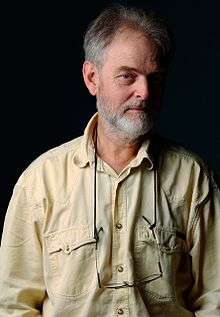Stephen Dalton (photographer)
| Stephen Dalton | |
|---|---|
 | |
| Born | 1937 (age 78–79) |
| Residence | Sussex |
| Nationality | British |
| Fields | Nature Photography |
Stephen Dalton (born 1937), is an English wildlife photographer, conservationist and author.
Photography career
Dalton’s work first became recognised during the early 1970s.[1] What attracted the attention of the photographers, biologists and the wider public, were his photographs that showed for the first time insects captured in free flight.[2]
His work was described by Popular Photography thus: "His achievement is a landmark event in the annals of nature photography . . . both Muybridge and Dalton showed the world what no man had ever done before", and by Leaders Magazine, New York: "His majestic work has contributed significantly to the awareness, beauty and purpose in the world".
Taken on ISO 25 Kodachrome film, the photographs were in critical detail and full colour, revealing to the world what insects looked like in full flight. High-speed nature photography has been his trademark ever since.
Dalton’s work first became widely known after the publication in 1975 of Borne on the Wind, about the extraordinary world of insect flight which was published worldwide in several languages. This was followed by a number of television appearances that during 1978 culminated in a one-hour BBC documentary in the popular The World About Us series which demonstrated how his specialized photography was carried out.
Since then Dalton has used his techniques to capture the too rapid to be seen activities of a wide variety of animals which at that time had never or rarely been observed, such as basilisk lizards running on the surface of water, swallows drinking on the wing and striking snakes.
Dalton’s most enduring image is on board NASA’s Voyager Spacecraft – a photograph of an insect in flight to accompany other works of art. These records were designed to last one billion years or more and are part of records conveying something of the science and culture of mankind to possible extraterrestrial beings.
Now Dalton lives in the southeast of England on a small farm with his wife, also a trained entomologist and photographer, where he encourages wildlife in all its forms. There are four children.
Bibliography
- 1967 Ants from Close-up with L. Hugh Newman
- 1968 Bees from Close-up
- 1971 Looking at Nature
- 1975 Borne on the Wind (The extraordinary world of insect flight)
- 1882 Caught in Motion (high-speed nature photography)
- 1983 Split Second
- 1986 The Secret Life of an Oakwood
- 1988 Secret Lives
- 1989 At the Water's Edge
- 1990 Vanishing Paradise with George Bernard (life in a tropical rainforest)
- 1992 The Secret Life of Garden
- 1999 The Miracle of Flight (the evolution and mechanism of flight)
- 1999 Secret Worlds
- 2008 Spiders: Ultimate Predators
Exhibitions
Exhibitions of Dalton’s work have been hung in several venues including:
- The Photographers' Gallery, London 1973
- The Barbican, London 1989
- The Royal Photographic Society, Bath 1993
- Canon Gallery, Petworth 2000
- Tate Britain, "How We Are: Photographing Britain" London 2007
- Montier-en-Der festival, France 2009
Awards & Honours
- Kodak Scholarship in Advanced Photography (1962)
- Hood Medal, Royal Photographic Society (1971)
- Nikon Award (1977)
- Silver Progress Medal, Royal Photographic Society (1978)
- Honorary Fellowship of the Royal Photographic Society (1978)
- Richard Farrand Award (1987)
- Sir Peter Kent Conservation Book Prize (At The Water's Edge & Vanishing Paradise) (1989 & 1991)
- Honorary Fellowship of the India International Photographic Council (1993)
- International Guest of Honour at Montier-en-Der festival on YouTube, France (2009)
Articles & Profiles
Numerous articles, biographical profiles and reviews in British, European and USA magazines including National Geographic, Airone, Country Life, GEO, BBC Wildlife, Canon Professional Network,[3] Audubon Magazine, International Wildlife, Reader's Digest, Radio Times, New Scientist, National Newspapers (including the Daily Telegraph[4] and Daily Mail)[5] and over ten full feature reviews in national colour supplements.
References
- ↑ "Stephen Dalton's Macrobatics". Practical Photography. March 1983.
- ↑ "Dalton's World". Audubon Magazine. 102 (4). August 2000.
- ↑ "Canon Professional Network - Stephen Dalton: The wildlife maestro".
- ↑ "Home-made camera captures moments of nature". The Daily Telegraph. London. 27 October 2010.
- ↑ "How photographer used 50-year-old kit to capture spectacular nature images on film". London. 27 October 2010.